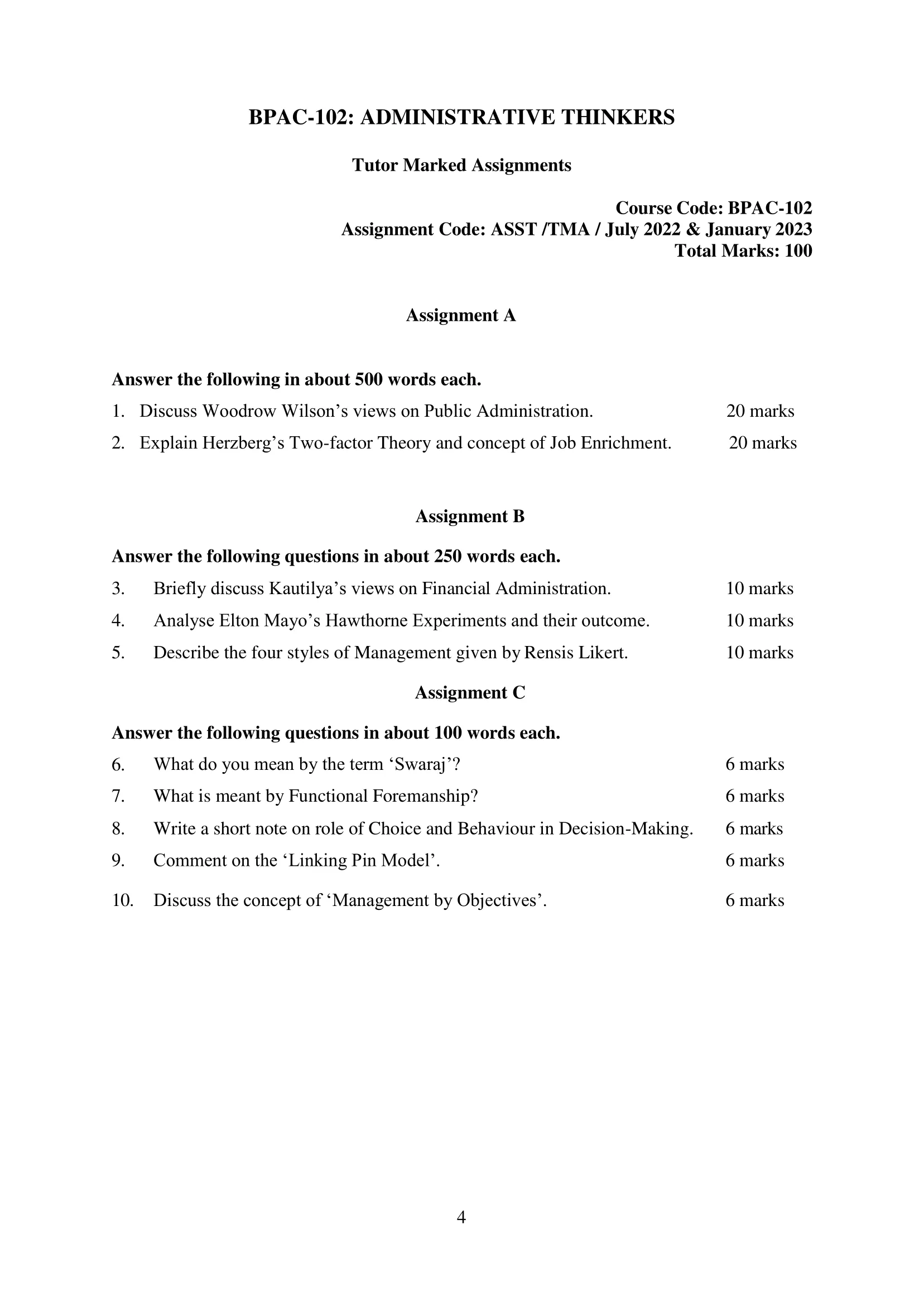
| Title | BPAC-102: IGNOU BAG Solved Assignment 2022-2023 |
| University | IGNOU |
| Degree | Bachelor Degree Programme |
| Course Code | BPAC-102 |
| Course Name | ADMINISTRATIVE THINKERS |
| Programme Name | Bachelor of Arts (General) |
| Programme Code | BAG |
| Total Marks | 100 |
| Year | 2022-2023 |
| Language | English |
| Assignment Code | ASST /TMA / July 2022 & January 2023 |
| Assignment PDF | Click Here |
| Last Date for Submission of Assignment: | For June Examination: 31st April For December Examination: 30th September |

Assignment A
Answer the following in about 500 words each.
1. Discuss Woodrow Wilson’s views on Public Administration.
Ans: Woodrow Wilson is a prominent political figure in American history who served as the 28th president of the United States from 1913 to 1921. Wilson was a well-respected academic and scholar before entering politics, having served as a professor of political science and president of Princeton University. His views on public administration were deeply influenced by his background in academia and his experience as a governor of New Jersey. Wilson’s views on public administration can be best understood through his essay “The Study of Administration,” which he wrote in 1887.
Wilson’s central thesis in “The Study of Administration” was that public administration should be considered as a separate and distinct field of study from politics. He argued that the science of administration should focus on the efficient and effective management of government agencies and the delivery of public services, rather than the political or policy goals of elected officials. In other words, Wilson believed that administrators should be neutral and objective in their work and focus on providing the best possible services to the public.
One of the key principles that Wilson advocated for was the separation of politics and administration. He believed that the political goals of elected officials should be kept separate from the day-to-day operations of government agencies. According to Wilson, this would help to ensure that administrators were able to focus on providing efficient and effective public services without being unduly influenced by political considerations. Wilson also believed that administrators should be appointed based on their expertise and qualifications, rather than their political connections.
Wilson also advocated for the use of scientific management techniques in public administration. He believed that government agencies should be run like businesses, with a focus on efficiency, productivity, and cost-effectiveness. Wilson argued that the principles of scientific management, such as specialization, standardization, and measurement, could be applied to government agencies to improve their effectiveness and efficiency. He also believed that government agencies should be organized along functional lines, with clear lines of authority and responsibility.
Another important aspect of Wilson’s views on public administration was his belief in the importance of professional training and education for public administrators. He believed that public administrators should be well-educated and trained in the principles of administration, as well as the specific areas in which they were working. Wilson believed that universities had an important role to play in the training and education of public administrators, and he advocated for the creation of academic programs in public administration.
2. Explain Herzberg’s Two-factor Theory and concept of Job Enrichment.
Ans: Herzberg’s Two-factor theory is a motivation theory that was developed by psychologist Frederick Herzberg in the 1950s. According to this theory, there are two sets of factors that contribute to job satisfaction and dissatisfaction. The first set of factors are called hygiene factors or extrinsic factors, which are the basic needs that must be met for employees to feel satisfied and not dissatisfied with their job. The second set of factors are called motivators or intrinsic factors, which are the factors that create job satisfaction and motivate employees to perform at a higher level.
Hygiene factors include things like salary, job security, working conditions, company policies, and supervision. These factors do not directly lead to job satisfaction, but their absence can lead to job dissatisfaction. For example, if an employee is not paid a fair wage, they may become dissatisfied with their job and look for other employment opportunities.
Motivators, on the other hand, are factors that create job satisfaction and motivate employees to perform at a higher level. These factors include things like recognition, the work itself, responsibility, advancement opportunities, and personal growth. When these factors are present, employees are more likely to be motivated and engaged in their work.
Herzberg’s theory suggests that organizations should focus on both hygiene factors and motivators to create a positive work environment and motivated workforce. In addition to addressing hygiene factors to prevent job dissatisfaction, organizations should also focus on providing motivators to increase job satisfaction and motivate employees to perform at their best.
One way that organizations can provide motivators is through job enrichment. Job enrichment is a management concept that involves increasing the level of responsibility and challenge in a job to provide employees with more opportunities for personal growth and development. Job enrichment involves giving employees more autonomy and control over their work, as well as opportunities to learn and grow in their roles.
By providing opportunities for job enrichment, organizations can help to create a more motivated and engaged workforce. Employees who are given more responsibility and autonomy are more likely to feel a sense of ownership over their work and take pride in their accomplishments. This can lead to higher levels of job satisfaction and motivation, as well as improved performance and productivity.
Assignment B
Answer the following questions in about 250 words each.
3. Briefly discuss Kautilya’s views on Financial Administration.
Ans: Kautilya, also known as Chanakya, was a renowned ancient Indian philosopher and political strategist who authored the Arthashastra, a comprehensive treatise on governance and economics. Kautilya’s views on financial administration are of significant relevance even in modern times due to their emphasis on efficient and accountable financial management.
Kautilya believed that financial administration was one of the most crucial aspects of governance, and it played a pivotal role in the development and stability of a state. He asserted that a robust financial system was the backbone of any state and that its efficient management was essential for the welfare of the people.
One of Kautilya’s primary recommendations was the creation of a system of accounting and audit to ensure that financial transactions were transparent and accountable. He emphasized the importance of keeping accurate and detailed records of revenue, expenditure, and debts. This system was also used to check corruption, mismanagement, and embezzlement of funds.
Kautilya also believed in a progressive taxation system, with the wealthy being taxed more heavily than the poor. He argued that the rich had a greater stake in the welfare of the state and should contribute more towards its development. He also recommended that taxes should be collected fairly, and the burden should not fall disproportionately on any particular segment of society.
Furthermore, Kautilya was a proponent of sound fiscal policies. He advocated for the maintenance of a surplus in the treasury, which could be used in times of crisis or to finance public works projects. He also recommended that expenditures should be carefully scrutinized, and only those that were necessary and beneficial to the people should be undertaken.
4. Analyse Elton Mayo’s Hawthorne Experiments and their outcome.
Ans: The Hawthorne experiments were a series of studies conducted in the 1920s and 1930s at the Hawthorne Works factory in Illinois, USA, by a team of researchers led by Elton Mayo. These experiments were aimed at investigating the effects of various factors, such as lighting, work hours, and other working conditions, on worker productivity and morale.
The initial experiments were focused on the effects of lighting on productivity. Mayo’s team found that increasing or decreasing the level of light did not have a significant impact on productivity. However, they observed that productivity increased regardless of whether the light level was increased or decreased. This finding led the researchers to conclude that other factors, such as social and psychological factors, were at play in determining worker productivity.
Mayo’s team then conducted a series of experiments to study the effects of other factors, such as work hours, rest periods, and incentives, on worker productivity. They found that these factors did not have a significant impact on productivity either. Instead, they observed that worker productivity was strongly influenced by social and psychological factors, such as the quality of interpersonal relationships among workers and between workers and management.
Based on these findings, Mayo concluded that workers were motivated not only by economic incentives but also by social and psychological factors. He argued that the work environment, including the social and psychological climate, had a significant impact on worker motivation, job satisfaction, and productivity.
The Hawthorne experiments had a profound impact on management theory and practice. They challenged the prevailing scientific management approach, which emphasized the importance of optimizing work processes and maximizing productivity through time and motion studies. Instead, Mayo’s findings highlighted the importance of human factors in the workplace and the need for managers to consider workers’ social and psychological needs.
The Hawthorne experiments also led to the development of the human relations movement in management theory, which emphasized the importance of developing a positive work environment, effective communication, and good interpersonal relationships among workers and between workers and management. The human relations approach emphasized the importance of treating workers as individuals with unique needs and motivations, rather than simply as cogs in a machine.
5. Describe the four styles of Management given by Rensis Likert.
Ans: Rensis Likert was an organizational psychologist who developed a four-fold model of management styles based on his research in the 1960s. The four styles of management according to Likert are exploitative/authoritative, benevolent/authoritative, consultative, and participative.
- Exploitative/authoritative style: In this style, managers tend to use coercion and threats to achieve goals. They often rely on a hierarchical and centralized management structure, where decisions are made at the top and passed down through the chain of command. Communication tends to be one-way, with little input or feedback from employees.
- Benevolent/authoritative style: This style is similar to the exploitative/authoritative style, but with a more paternalistic approach. Managers may show concern for the welfare of employees, but still maintain a hierarchical management structure and use a top-down decision-making process.
- Consultative style: In this style, managers seek input from employees and consider their opinions and suggestions when making decisions. However, the final decision still rests with the manager, who retains a degree of control over the decision-making process.
- Participative style: In the participative style, managers share decision-making power with employees, often delegating tasks and responsibilities to teams. Communication is open and two-way, and employees are encouraged to participate in problem-solving and decision-making processes.
According to Likert, the participative style is the most effective and productive, as it fosters a sense of ownership and commitment among employees, leading to higher job satisfaction and better performance. The consultative style is also effective, but to a lesser extent, while the exploitative/authoritative and benevolent/authoritative styles are less effective and can lead to low morale, resistance, and turnover.
Assignment C
Answer the following questions in about 100 words each.
6. What do you mean by the term ‘Swaraj’?
Ans: Swaraj is a term that originated in ancient India and has been used throughout Indian history, including during the Indian independence movement in the 20th century. Swaraj can be translated to mean self-rule, self-governance, or self-determination. The term is closely associated with Mahatma Gandhi, who used it to describe his vision of India as a nation governed by the people, free from foreign domination and exploitation. Gandhi believed that Swaraj was not just a political concept, but a moral and spiritual one as well, requiring individuals to take responsibility for their actions and to act with integrity and compassion.
7. What is meant by Functional Foremanship?
Ans: Functional foremanship is a management concept developed by Frederick Winslow Taylor, a pioneer of scientific management, and expanded upon by his disciple, Harrington Emerson. The concept involves the division of labor and responsibilities among managers in a manufacturing plant or other industrial setting.
Under the functional foremanship system, the functions of production are divided into two categories: planning and execution. The planning function is performed by one set of managers, while the execution function is performed by another set of managers. Each set of managers is responsible for a specific area of the production process and has authority over a specific group of workers.
The planning managers are responsible for tasks such as planning the work, designing production processes, scheduling work, and controlling the quality of the final product. The execution managers, on the other hand, are responsible for the physical execution of the work, such as operating machines, managing materials, and supervising workers.
The functional foremanship system is based on the principle of specialization, with each manager responsible for a specific area of expertise. This system is designed to improve efficiency, increase productivity, and reduce costs by ensuring that each worker is performing the task for which they are best suited. However, it has been criticized for its emphasis on division and control, and for ignoring the importance of worker autonomy and participation in the production process.
8. Write a short note on role of Choice and Behaviour in Decision-Making.
Ans: Choice and behavior play a crucial role in the decision-making process. When we make decisions, we are often influenced by our own preferences, beliefs, and biases. We may also be influenced by external factors, such as the opinions of others, social norms, or situational factors.
In terms of choice, we make decisions by selecting one option over another. This selection process is often influenced by our preferences, which are shaped by our past experiences and personal values. For example, we may choose a particular brand of clothing because it reflects our personal style, or we may choose a certain type of food because it is consistent with our dietary preferences.
Behavior is also an important factor in decision-making. Our behavior is influenced by the choices we make, but it is also shaped by external factors such as social norms, peer pressure, and situational factors. For example, we may choose to attend a social event because we value social interaction, but our behavior at the event may be influenced by the behavior of others and the situational context.
In order to make effective decisions, it is important to be aware of our own preferences and biases, as well as the external factors that may influence our choices and behavior. It is also important to consider the potential consequences of our decisions, both for ourselves and for others. By being aware of these factors and taking them into account, we can make more informed and effective decisions.
9. Comment on the ‘Linking Pin Model’.
Ans: The Linking Pin Model is a management theory introduced by Rensis Likert in the 1960s. The model is based on the idea that different levels of an organization are linked together by managers who act as “linking pins” between the different levels. The model proposes that effective communication and coordination between different levels of the organization are critical for its success.
The Linking Pin Model emphasizes the importance of effective communication and cooperation between different levels of an organization. According to the model, managers act as linking pins between different levels, and their role is to facilitate the flow of information and coordination between the levels. This can help to ensure that everyone in the organization is working towards the same goals, and that there is a common understanding of what those goals are.
The Linking Pin Model has been widely used in management practice and has influenced many other management theories. However, it has also been criticized for oversimplifying the complex realities of organizational behavior. Some critics have argued that the model places too much emphasis on the role of managers and does not take into account the individual motivations and behaviors of employees. Despite these criticisms, the Linking Pin Model remains a useful framework for understanding the importance of communication and coordination in organizational success.
10. Discuss the concept of ‘Management by Objectives’.
Ans: Management by Objectives (MBO) is a management approach that involves setting specific objectives and goals for individual employees and departments within an organization. The key principle of MBO is to align organizational goals and objectives with individual goals and objectives, and to use these goals as a basis for performance evaluation and decision-making. MBO involves a continuous process of setting goals, evaluating progress, and adjusting objectives as needed. MBO can help to create a sense of ownership and accountability among employees, and can improve communication and collaboration within an organization. It is a useful tool for aligning employee goals with organizational objectives and promoting accountability and performance.
How to Download BPAC-102 Solved Assignment?
You can download it from the www.edukar.in, they have a big database for all the IGNOU solved assignments.
Is the BPAC-102 Solved Assignment Free?
Yes this is absolutely free to download the solved assignment from www.edukar.in
What is the last submission date for BPAC-102 Solved Assignment?
For June Examination: 31st April, For December Examination: 30th October







